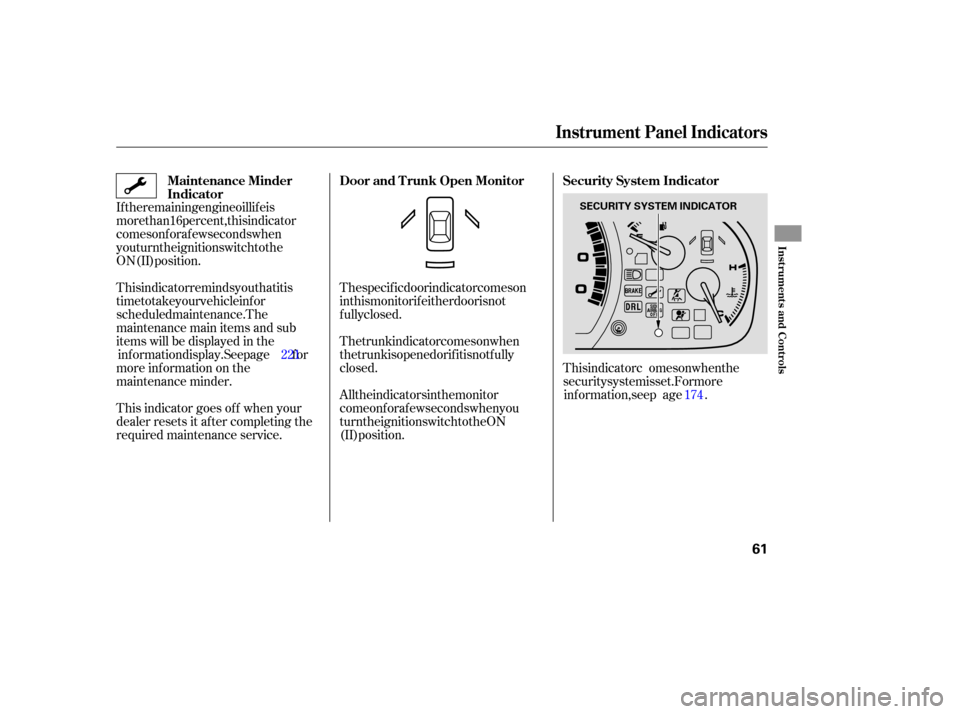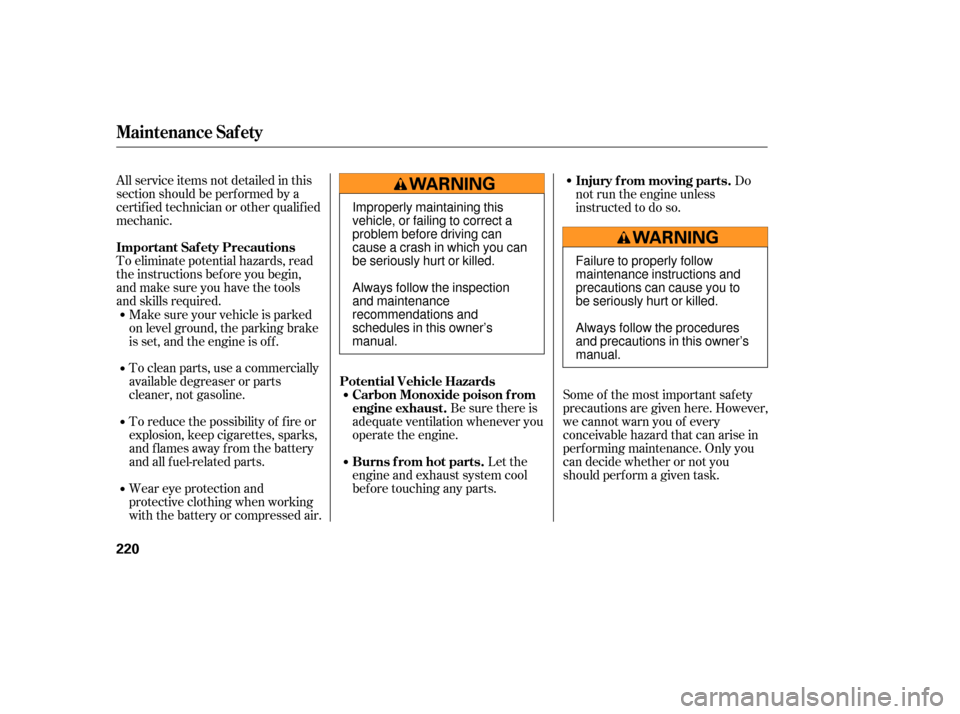Page 58 of 319
�Î�Î
�Î
If equipped.
:
Canadian models
Instrument Panel
56
LOW OIL PRESSURE INDICATOR
CRUISE MAIN INDICATOR
VEHICLE STABILITY ASSIST (VSA)
SYSTEM INDICATOR
CRUISE CONTROL INDICATOR
ANTI-LOCK BRAKE SYSTEM
(ABS) INDICATOR
SEAT BELT REMINDER
INDICATOR
SUPPLEMENTAL
RESTRAINT SYSTEM
INDICATOR
SIDE AIRBAG OFF INDICATOR
LOW
FUEL INDICATOR
HIGH BEAM INDICATOR
PARKING BRAKE AND BRAKE
SYSTEM INDICATOR
TURN
SIGNAL AND HAZARD
WARNING INDICATORS
IMMOBILIZER
SYSTEM INDICATOR
MALFUNCTION
INDICATOR LAMP
CHARGING
SYSTEM
INDICATOR (P.57)
(P . 59)
LIGHTS ON INDICATOR
(p.60 )
( P.57)
(P.57)
(P.59) (P.60)
(P.60)
(P.58) (P.62)
VSA ACTIVATION INDICATOR (P.62)
(P.62) (P.62)
(P.59)
MAINTENANCE MINDER
INDICATOR (P.61)
DOOR AND TRUNK OPEN
MONITOR (P.61)
(P.57)
(P.58)
SECURITY SYSTEM INDICATOR
WASHER
LEVEL INDICATOR (P.60)
(P.61)
DAYTIME RUNNING LIGHTS INDICATOR (P.60)
(P.58)
EX-V6 with A/T model is shown.
�����—�����—�����y�
�������������y���
�(���%�������y���������y
Page 63 of 319

This indicator comes on when the
security system is set. For more info rmation, see p age .
The specific door indicator comes on
in this monitor if either door is not
fully closed.
The trunk indicator comes on when
the trunk is opened or if it is not fully
closed.
All the indicators in the monitor
come on for a few seconds when you
turn the ignition switch to the ON
(II) position.
If the remaining engine oil life is
more than 16 percent, this indicator
comes on for a few seconds when
you turn the ignition switch to the
ON (II) position.
This indicator reminds you that it is
time to take your vehicle in for
scheduled maintenance. The
maintenance
main items and sub
items will be displayed in the
information display. See page for
more inf ormation on the
maintenance minder.
This indicator goes of f when your
dealer resets it after completing the
required maintenance service. 174
221 Security System Indicator
Maintenance Minder
Indicator Door and T runk Open Monitor
Instrument Panel Indicators
Inst rument s and Cont rols
61
SECURITY SYSTEM INDICATOR
�����—�����—�����y�
�������������y���
�(���%�������y���������y
Page 65 of 319
To switch the information display
between the odometer/trip meter,
outside temperature/trip meter (if
equipped), and engine oil lif e and
maintenance item code(s), press the
Select/Reset knob repeatedly.
This shows the total distance your
vehicle has been driven. It measures
miles in U.S. models and kilometers
in Canadian models.
It is illegal under U.S. f ederal law and
Canadian provincial regulations to
disconnect, reset, or alter the
odometer with the intent to change
the number of miles or kilometers
indicated. When you turn the ignition switch to
the ON (II) position, your last
selection appears in the display.
Gauges
Odometer
Inst rument s and Cont rols
63
TACHOMETERSPEEDOMETER
FUEL GAUGE
SELECT/RESET
KNOB TEMPERATURE
GAUGE
INFORMATION DISPLAY
U.S. A/T model is shown. ODOMETER/TRIP METER/OUTSIDE
TEMPERATURE INDICATOR/CHECK FUEL CAP
INDICATOR/MAINTENANCE MINDER
�����—�����—�����y�
�������������y���
�(���%�������y���������y
Page 186 of 319

Help assure your vehicle’s f uture
reliability and perf ormance by paying
extra attention to how you drive
during the f irst 600 miles (1,000 km).
During this period:In addition, in order to maintain good
perf ormance, f uel economy, and
emissions control, we strongly
recommend, in areas where it is
available, the use of gasoline that
does NOT contain manganese-based
f uel additives such as MMT.
Use of gasoline with these additives
may adversely af f ect perf ormance,
and cause the malfunction indicator
lamp on your instrument panel to
come on. If this happens, contact
your authorized dealer f or service.
Avoid full-throttle starts and rapid
acceleration.
You should also f ollow these
recommendations with an
overhauled or exchanged engine, or
when the brakes are replaced. Your vehicle is designed to operate
on unleaded gasoline with a pump
octane number of 87 or higher. Use
of a lower octane gasoline can cause
a persistent, heavy metallic rapping
noise that can lead to engine damage.
Some gasoline today is blended with
oxygenates such as ethanol or
MTBE. Your vehicle is designed to
operate on oxygenated gasoline
containing up to 10 percent ethanol
by volume and up to 15 percent
MTBE by volume. Do not use
gasoline containing methanol.
We recommend using quality
gasolines containing detergent
additives that help prevent fuel
system and engine deposits. If you drive with the low engine
speed (below than about 1,000 rpm),
you may f eel the engine knocking. In
this case, you can use premium
unleaded gasoline with a pump
octane number of 91 or higher to
prevent the engine f rom knocking.
Avoidhardbrakingforthefirst
200 miles (300 km).
Do not tow a trailer. Do not change the oil until the
scheduled maintenance time.
On EX-V6 model with manual
transmission
Break-in Period Fuel Recommendation
Break-in Period, Fuel Recommendation
184
�����—�����—�����y�
���������
���y���
�(���%�������y���
�����y
Page 191 of 319
Refer to
on page for information
about checking other items on your
vehicle.
Look
at the coolant level in the
radiator reserve tank. Make sure it is
between the MAX and MIN lines. If
it is below the MIN line, see
on page .
236 226
Service Station Procedures
Engine Coolant Check
Owner’s Maintenance
Checks
A dding
Engine Coolant
Bef ore Driving
189
UPPER MARK
LOWER MARK RESERVE TANK
4-cylinder models MIN MAX MAX
RESERVE TANK
6-cylinder models MIN
6-cylinder models
�����—�����—�����y�
�������������y���
�(���%�������y���
�����y
Page 192 of 319
Try to maintain a constant speed.
Everytimeyouslowdownand
speed up, your vehic le uses extra
fuel. Use cruise control when
appropriate.
Combine several short trips into
one.
The air conditioning puts an extra
load on the engine which makes it
usemorefuel.Usethefresh-air
ventilation when possible.
Always
maintain your vehicle
according to the maintenance
messages displayed in the
inf ormation display. See (see page
).
an underinf lated tire
causes more ‘‘rolling resistance,’’
which uses more f uel.
The build-up of snow or mud on
your vehicle’s underside adds
weight and rolling resistance.
Frequent cleaning helps your f uel
mileage and reduces the chance of
corrosion.
Drive moderately. Rapid
acceleration, abrupt cornering,
and hard braking use more f uel.
Always drive in the highest gear
possible. 226
For example,
Fuel Economy
Improving Fuel Economy
Owner’s
Maintenance Checks
190
�����—�����—�����y�
���������
���y���
�(���%�������y���
�����y
Page 221 of 319

This section explains why it is
important to keep your vehicle well
maintained and how to follow basic
maintenance safety precautions.
If you have the skills and tools to
perform more complex maintenance
tasks on your vehicle, you may want
to purchase the service manual. See
page for information on how to
obtain a copy, or see your dealer. This section also includes
instructions on how to read the
maintenance messages in the
inf ormation display, a maintenance
record, and instructions f or simple
maintenance tasks you may want to
take care of yourself . ......................
Maintenance Saf ety .220
....................
Maintenance Minder .221
....................
Maintenance Record .228
..............................
Fluid Locations .230
........................
Adding Engine Oil .232
.........
Changing the Oil and Filter .233
..............................
Engine Coolant .236
....................
Windshield Washers .238
.......................
Transmission Fluid .239
..........
Automatic Transmission .239
..............
Manual Transmission .242
................
Brake and Clutch Fluid .243
....................
Power Steering Fluid .245
....................................
Timing Belt .246
.............................................
Lights .246
................
Cleaning the Seat Belts .251
.....................................
Floor Mats .251
..................
Dust and Pollen Filter .252
.................................
Wiper Blades .252
...............................................
Tires .254
...................
Checking the Battery .260
.............................
Vehicle Storage .262
305
Maintenance
Maint enance
219
�����—�����—�����y�
�������������y���
�(���%�������y���������y
Page 222 of 319

All service items not detailed in this
section should be perf ormed by a
certif ied technician or other qualif ied
mechanic.
To eliminate potential hazards, read
the instructions bef ore you begin,
and make sure you have the tools
and skills required.To clean parts, use a commercially
available degreaser or parts
cleaner, not gasoline. Be sure there is
adequate ventilation whenever you
operate the engine.
Let the
engine and exhaust system cool
bef ore touching any parts. Do
not run the engine unless
instructed to do so.
Some of the most important saf ety
precautions are given here. However,
we cannot warn you of every
conceivable hazard that can arise in
perf orming maintenance. Only you
can decide whether or not you
should perf orm a given task.
Make sure your vehicle is parked
on level ground, the parking brake
is set, and the engine is of f .
To reduce the possibility of f ire or
explosion, keep cigarettes, sparks,
and flames away from the battery
and all f uel-related parts.
Wear eye protection and
protective clothing when working
with the battery or compressed air.
Maintenance Saf ety
Important Saf ety Precautions
Potential Vehicle HazardsCarbon Monoxide poison f rom
engine exhaust.
Burns f rom hot parts. Injury f rom moving parts.
220
Improperly maintaining this
vehicle, or failing to correct a
problem before driving can
cause a crash in which you can
be seriously hurt or killed.
Always follow the inspection
and maintenance
recommendations and
schedules in this owner’s
manual.
Failure to properly follow
maintenance instructions and
precautions can cause you to
be seriously hurt or killed.
Always follow the procedures
and precautions in this owner’s
manual.
�����—�����—�����y�
���������
���y���
�(���%�������y���������y